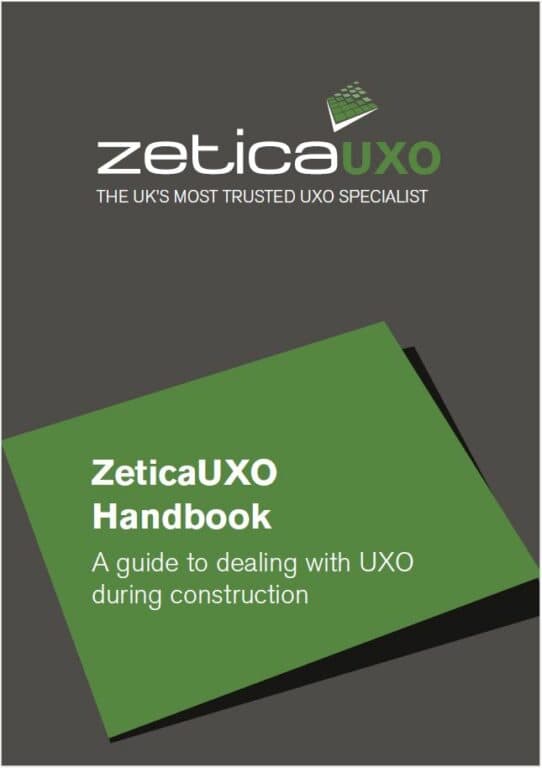Download the latest guidelines relating to the UXO and explosives industry in the UK.
There are no definitive regulations for the UXO industry, yet guidance is available to help developers understand the potential UXO risk on their site. The most important guidance documents are detailed below.
Zetica UXO Handbook
The Zetica UXO Handbook is designed to simplify industry guidance and help you understand the services undertaken on your behalf by a UXO specialist.
The handbook is divided into three sections. Depending on what stage of the project you are at, you can quickly find the information that is right for you. Flowcharts will help you navigate each chapter.
- Are you planning to develop a site?
- Are you working on site?
- Have you just found a bomb?
Contact us to enquire about obtaining a copy of the Zetica UXO Handbook.
Contact us

BEST PRACTICE PAPER – UXO RISK ASSESSMENT: WHERE ARE WE 6 YEARS ON FROM THE PUBLICATION OF CIRIA’S UXO GUIDANCE
This paper holds a mirror up to the UXO industry and evaluates how some specialists are failing to commit to the intention and essential principles of the CIRIA guidance, and offers developers an insight into some of the most important considerations when addressing the UXO risk on a site.
DownloadCIRIA C681, UNEXPLODED ORDNANCE (UXO): A GUIDE FOR THE CONSTRUCTION INDUSTRY
This publication provides the UK construction industry with a set and defined process for the management of risks associated with UXO from WWI and WWII aerial bombardment. It is also broadly applicable to the risks from other forms of UXO that might be encountered.
Visit CIRIA BookshopCIRIA C754, ASSESSMENT AND MANAGEMENT OF UNEXPLODED ORDNANCE (UXO) RISK IN THE MARINE ENVIRONMENT
This publication provides guidance to organisations involved with the planning, design, delivery, operation and maintenance, decommissioning or regulation of projects in the marine environment on the assessment and management of unexploded ordnance (UXO) risks.
Visit CIRIA BookshopGUIDANCE NOTES FOR COMMERCIAL EXPLOSIVE ORDNANCE DISPOSAL OPERATIONS IN GREAT BRITAIN
This publication provides guidance on best working practices for dealing with potentially unexploded munitions discovered on the landmass of Great Britain or in its territorial waters. The Guidance Note is not a substitute for officially recognised training and qualifications but is intended to assist all involved in fulfilling their responsibilities for:
- the safety of employees, contractors and service personnel.
- the safety of people living or working in the vicinity of the EOD Operation.
DEALING WITH MUNITIONS IN MARINE SEDIMENTS
The advice in this document provides practical guidance to operators of the options available to minimise the occurrence of munitions in marine dredged aggregate, and the steps needed to manage any encounters that may take place.
DownloadLAND CONTAMINATION: TECHNICAL GUIDANCE ON SPECIAL SITES: MOD LAND
This guidance presents an overview of the key aspects of MoD Land and the types of sites and their distribution and extent in the UK. It also provides a description of the main processes and activities that have occurred on MoD Land which are likely to have resulted in ground contamination. Whilst MoD land may contain a wide range of contaminant sources, this guidance mainly concentrates on those contaminants which are peculiar to such sites.
Download
LAND CONTAMINATION: TECHNICAL GUIDANCE ON SPECIAL SITES: EXPLOSIVES MANUFACTURING & PROCESSING SITES
This guidance presents an overview of the key aspects of sites where explosives have been manufactured, stored or processed, the types of sites that may have contamination of this nature, and their distribution and extent in the UK. It also provides a description of the main processes and activities that have occurred on explosives manufacturing and processing sites that are likely to have resulted in ground contamination. The processing of explosives covers the chemical manufacture, mixing, filling and packing of explosives into ammunition or any explosive device. Whilst explosives manufacturing and processing sites can contain a range of contaminants, this guidance mainly concentrates on the contaminants of concern which are specific to such sites – namely the explosives (and associated devices), their precursors, breakdown products and waste disposal.
DownloadLAND CONTAMINATION: TECHNICAL GUIDANCE ON SPECIAL SITES: CHEMICAL WEAPONS SITES
This guidance presents a general overview of the key points relating to sites where chemical weapons (CW) agents may be encountered, the types of sites which may have contamination of this nature, and their distribution and extent in the UK. It also provides a description of the main processes and activities which have occurred on sites where CW agents have been manufactured, tested, stored or disposed of and which are likely to have resulted in ground contamination.
DownloadA GUIDE TO INTERNATIONAL MINE ACTION STANDARDS
Developing International Mine Action Standards (IMAS) and supporting the mine action community by dissemination of knowledge and best practices are core mandates of the Geneva International Centre for Humanitarian Demining (GICHD). IMAS have been developed in coordination with the United Nations Mine Action Service (UNMAS) and the IMAS Review Board representing the Mine Action Community to improve safety, efficiency, quality and confidence in mine action.
DownloadSTATISTICAL BASIS FOR ASSESSING THE RISK OF UNEXPLODED BOMBS DURING SITE INVESTIGATIONS AND FOUNDATION PILING
The threat of buried unexploded bombs (UXB) to land developments in some areas of the UK has been well publicised. A formalised statistical approach to assessing this risk for land owners, developers or consultants is, however, lacking. This note introduces a statistically rigorous method for quantifying these risks so that the potential impact of a few boreholes on a site or a dense grid of clustered piles can be accurately quantified.
DownloadUNDERSTANDING THE LIMITS OF DETECTABILITY OF UNEXPLODED ORDNANCE
This note spotlights detectability issues and recommends ways of improving survey integrity and quantifying detection assurance levels when addressing UXO risk.
Download
